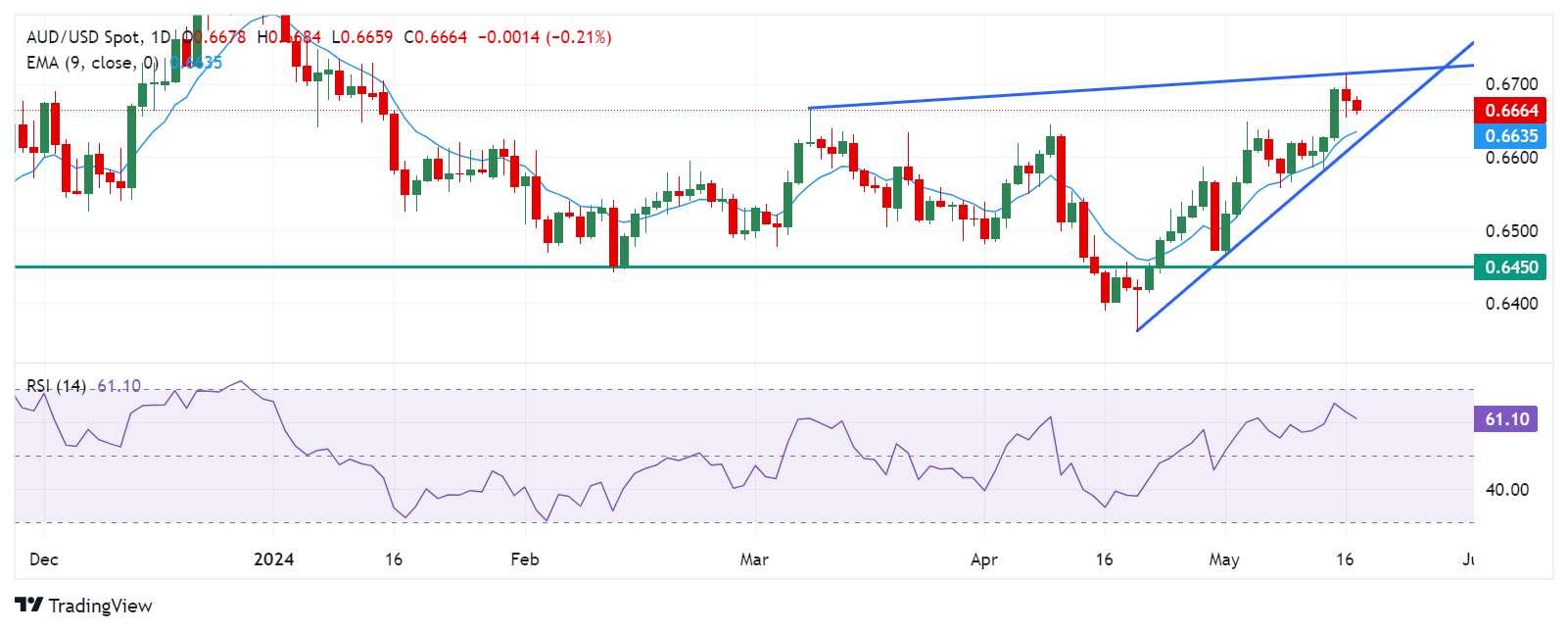- The Australian Dollar extends its losses after mixed economic data from China on Friday.
- The Australian Dollar struggles as Australia’s 10-year bond yield has dropped to a monthly low of 4.2%.
- China’s Retail Sales increased for the consecutive 15th month but the softest gain in this sequence.
- The US Dollar has rebounded as the Fed remains cautious about inflation and potential rate cuts in 2024.
The Australian Dollar (AUD) continues to experience a decline for the second consecutive session, largely influenced by recent mixed economic data from China released on Friday. Any economic change in the Chinese economy could catalyze the Australian market as both nations are close trade partners. The Aussie Dollar had already been under pressure after Australia's employment figures released on Thursday presented a mixed picture.
The Australian Dollar’s decline is bolstered as the yield on Australia’s 10-year government bond has dropped to around 4.2%, marking its lowest level in a month. This decline in bond yields is a reaction to the domestic jobs report, which showed an unexpected slowing in wage growth during the first quarter. The slowing wage growth has led markets to discount the possibility of any interest rate hikes by the Reserve Bank of Australia (RBA).
The US Dollar Index (DXY), which gauges the performance of the US Dollar (USD) against six major currencies, has rebounded from a multi-week low of 104.08 marked on Thursday. The Federal Reserve (Fed) maintains a cautious stance regarding inflation and the potential for rate cuts in 2024. Investors will take more cues from the Minneapolis Fed President Neel Kashkari and San Francisco Fed President Mary Daly's speeches later in the day.
Daily Digest Market Movers: Australian Dollar depreciates after mixed Chinese data
- China's Retail Sales increased 2.3% year-over-year in April, down from March's 3.1% and falling short of the expected 3.8%. This marks the 15th consecutive month of growth in retail activity but represents the slowest uptick in this trend. Meanwhile, Industrial Production improved 6.7% YoY, surpassing the anticipated 5.5% and the previous recording of 4.5%.
- The US Department of Labor released the US Initial Jobless Claims on Thursday. The number of Americans filing new claims for jobless benefits rose to 222,000 for the week ending May 10, surpassing the market consensus of 220,000 but below the previous week's figure of 232,000.
- On Thursday, Federal Reserve Bank of Atlanta President Raphael Bostic emphasized the need for patience with interest rates, noting that substantial pricing pressure persists in the US economy. Additionally, Cleveland Fed President Loretta Mester indicated that it might take longer than anticipated to confidently ascertain the inflation trajectory, suggesting that the Fed should maintain its restrictive stance for an extended period.
- Australia’s Wage Price Index (QoQ) increased by 0.8% in the first quarter, falling short of the market's forecast of a 0.9% rise. This quarter's increase is the smallest since late 2022. Additionally, annual pay growth slowed slightly to 4.1%, down from the previous 4.2%, and below market expectations.
- Sarah Hunter, Chief Economist and Assistant Governor (Economic) at the Reserve Bank of Australia (RBA), delivered a speech at the REIA Centennial Congress on Thursday. During her address, Hunter explored various potential strategies to address the imbalance between housing supply and demand growth. This issue looms large in Australia, with escalating prices, rents, and homelessness posing significant challenges.
- US Consumer Price Index (CPI) decelerated to 0.3% month-over-month in April and came in at a lower than expected 0.4% reading. While Retail Sales flattened, falling short of the expected increase of 0.4%.
- On Tuesday, the Australian Budget for 2024-25 returned to a deficit after recording a surplus of $9.3 billion in 2023-24. The Australian government aims to tackle headline inflation and alleviate the cost of living pressures by allocating billions to reduce energy bills and rent, alongside initiatives to lower income taxes.
- A Reuters report cited Treasurer of Australia Jim Chalmers, expressing his expectation that the current headline inflation rate of 3.6% will return to the Reserve Bank of Australia’s target range of 2-3% by the end of the year. If this scenario unfolds, the central bank will likely consider cutting interest rates earlier than markets had anticipated.
- Federal Reserve Chair Jerome Powell has anticipated a continued decline in inflation on Tuesday. Powell expressed less confidence in the disinflation outlook compared to previous assessments. He also highlighted that Gross Domestic Product (GDP) growth is expected to reach 2% or higher, attributing this positive forecast to the strength of the labor market.
Technical Analysis: Australian Dollar falls toward 0.6650
The Australian Dollar trades around 0.6660 on Friday. Observing the daily chart for AUD/USD showed an ascending triangle formation. Additionally, the 14-day Relative Strength Index (RSI) suggests a bullish sentiment, holding above the 50 mark.
The AUD/USD pair could challenge the upper threshold of the ascending triangle, resting near the four-month peak of 0.6714. A breach above this level might prompt exploration toward the significant barrier at 0.6750.
Conversely, potential support stands at the nine-day Exponential Moving Average (EMA) at 0.6634, followed by the lower boundary of the ascending triangle around 0.6610. A breakdown below this level could exert downward pressure, directing attention toward the throwback support at 0.6550.
AUD/USD: Daily Chart
Australian Dollar price today
The table below shows the percentage change of the Australian Dollar (AUD) against listed major currencies today. The Australian Dollar was the weakest against the US Dollar.
| USD | EUR | GBP | CAD | AUD | JPY | NZD | CHF | |
| USD | 0.07% | 0.07% | 0.10% | 0.19% | 0.27% | 0.12% | 0.19% | |
| EUR | -0.07% | 0.02% | 0.03% | 0.14% | 0.21% | 0.07% | 0.11% | |
| GBP | -0.08% | -0.01% | 0.02% | 0.13% | 0.19% | 0.03% | 0.10% | |
| CAD | -0.10% | -0.04% | -0.02% | 0.10% | 0.17% | 0.02% | 0.09% | |
| AUD | -0.20% | -0.13% | -0.11% | -0.10% | 0.07% | -0.07% | -0.01% | |
| JPY | -0.27% | -0.20% | -0.20% | -0.17% | -0.08% | -0.14% | -0.09% | |
| NZD | -0.12% | -0.06% | -0.05% | -0.02% | 0.07% | 0.14% | 0.05% | |
| CHF | -0.19% | -0.12% | -0.10% | -0.08% | 0.02% | 0.08% | -0.05% |
The heat map shows percentage changes of major currencies against each other. The base currency is picked from the left column, while the quote currency is picked from the top row. For example, if you pick the Euro from the left column and move along the horizontal line to the Japanese Yen, the percentage change displayed in the box will represent EUR (base)/JPY (quote).
Australian Dollar FAQs
One of the most significant factors for the Australian Dollar (AUD) is the level of interest rates set by the Reserve Bank of Australia (RBA). Because Australia is a resource-rich country another key driver is the price of its biggest export, Iron Ore. The health of the Chinese economy, its largest trading partner, is a factor, as well as inflation in Australia, its growth rate and Trade Balance. Market sentiment – whether investors are taking on more risky assets (risk-on) or seeking safe-havens (risk-off) – is also a factor, with risk-on positive for AUD.
The Reserve Bank of Australia (RBA) influences the Australian Dollar (AUD) by setting the level of interest rates that Australian banks can lend to each other. This influences the level of interest rates in the economy as a whole. The main goal of the RBA is to maintain a stable inflation rate of 2-3% by adjusting interest rates up or down. Relatively high interest rates compared to other major central banks support the AUD, and the opposite for relatively low. The RBA can also use quantitative easing and tightening to influence credit conditions, with the former AUD-negative and the latter AUD-positive.
China is Australia’s largest trading partner so the health of the Chinese economy is a major influence on the value of the Australian Dollar (AUD). When the Chinese economy is doing well it purchases more raw materials, goods and services from Australia, lifting demand for the AUD, and pushing up its value. The opposite is the case when the Chinese economy is not growing as fast as expected. Positive or negative surprises in Chinese growth data, therefore, often have a direct impact on the Australian Dollar and its pairs.
Iron Ore is Australia’s largest export, accounting for $118 billion a year according to data from 2021, with China as its primary destination. The price of Iron Ore, therefore, can be a driver of the Australian Dollar. Generally, if the price of Iron Ore rises, AUD also goes up, as aggregate demand for the currency increases. The opposite is the case if the price of Iron Ore falls. Higher Iron Ore prices also tend to result in a greater likelihood of a positive Trade Balance for Australia, which is also positive of the AUD.
The Trade Balance, which is the difference between what a country earns from its exports versus what it pays for its imports, is another factor that can influence the value of the Australian Dollar. If Australia produces highly sought after exports, then its currency will gain in value purely from the surplus demand created from foreign buyers seeking to purchase its exports versus what it spends to purchase imports. Therefore, a positive net Trade Balance strengthens the AUD, with the opposite effect if the Trade Balance is negative.
Information on these pages contains forward-looking statements that involve risks and uncertainties. Markets and instruments profiled on this page are for informational purposes only and should not in any way come across as a recommendation to buy or sell in these assets. You should do your own thorough research before making any investment decisions. FXStreet does not in any way guarantee that this information is free from mistakes, errors, or material misstatements. It also does not guarantee that this information is of a timely nature. Investing in Open Markets involves a great deal of risk, including the loss of all or a portion of your investment, as well as emotional distress. All risks, losses and costs associated with investing, including total loss of principal, are your responsibility. The views and opinions expressed in this article are those of the authors and do not necessarily reflect the official policy or position of FXStreet nor its advertisers. The author will not be held responsible for information that is found at the end of links posted on this page.
If not otherwise explicitly mentioned in the body of the article, at the time of writing, the author has no position in any stock mentioned in this article and no business relationship with any company mentioned. The author has not received compensation for writing this article, other than from FXStreet.
FXStreet and the author do not provide personalized recommendations. The author makes no representations as to the accuracy, completeness, or suitability of this information. FXStreet and the author will not be liable for any errors, omissions or any losses, injuries or damages arising from this information and its display or use. Errors and omissions excepted.
The author and FXStreet are not registered investment advisors and nothing in this article is intended to be investment advice.
Recommended content
Editors’ Picks

AUD/USD holds gains near 0.6250 but upside appears limited
AUD/USD remains on the front-foot near 0.6250 following the previous day's good two-way price swings amid confusion over Trump's tariff plans. The Aussie, meanwhile, remain close to over a two-year low touched last week in the wake of the RBA's dovish shift, China's economic woes and US-China trade war fears.

USD/JPY: Bulls retain control above 158.00, Japanese intervention risks loom
USD/JPY is off multi-month top but stays firm above 158.00 in the Asian session on Tuesday. Doubts over the timing when the BoJ will hike rates again and a broad-based US Dollar rebound, following Monday's Trump tariffs speculation-led sell-off, keep the pair supported ahead of US jobs data.

Gold price struggles to lure buyers amid hawkish Fed, elevated bond yields
Gold price trades with a negative bias for the third straight day on Tuesday, though it lacks follow-through amid uncertainty over Trump's tariff plans. Moreover, the recent USD pullback from over a two-year high and geopolitical risks support the safe-haven XAU/USD.

Ripple's XRP eyes rally to new all-time high after 40% spike in open interest
Ripple's XRP trades near $2.40, up 1% on Monday following a 40% surge in its futures open interest. The surge could help the remittance-based token overcome the key resistance of a bullish pennant pattern.

Five fundamentals for the week: Nonfarm Payrolls to keep traders on edge in first full week of 2025 Premium
Did the US economy enjoy a strong finish to 2024? That is the question in the first full week of trading in 2025. The all-important NFP stand out, but a look at the Federal Reserve and the Chinese economy is also of interest.

Best Forex Brokers with Low Spreads
VERIFIED Low spreads are crucial for reducing trading costs. Explore top Forex brokers offering competitive spreads and high leverage. Compare options for EUR/USD, GBP/USD, USD/JPY, and Gold.
